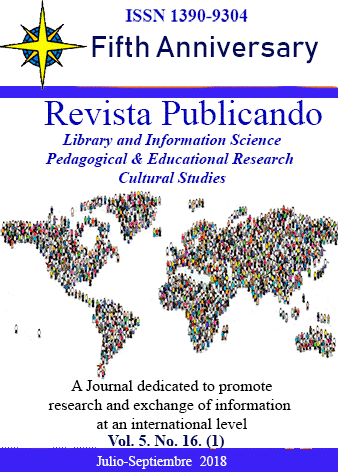Resumen
This article is devoted to the phenomenon of multimedia cultural-linguistic environment, as a factor of successful mastering of foreign language. The issues of creation of foreign communicative space, based on Internet resources, are considered in the article. The examples of information resources, with the help of which German-speaking cultural-linguistic environment can be created, are given in the work. In the organized cultural-linguistic environment, an active perception of information is realized. Performing the tasks, developed for audio and video records, students are in the state of intellectual stress, and the material is memorized arbitrary. The article analyzes the advantages of staying in multimedia cultural-linguistic environment. These are the use of several channels of socio-cultural information in the process of training, and the possibility of using various types of information (texts, audio and video materials of all styles and genres). It should be noted, that students independently immerse themselves in the modeled foreign reality. Due to this, they can implement metacognitive strategies in learning process. The possibilities of listening and watching the material at any time repeatedly, as well as the combination with other activities, are undeniable advantages of staying in the environment. This environment has a positive impact on the development of all types of speech activity. There are the incidental memorization of grammatical constructions, digestion of pronunciation norms, consolidation of lexical material, and contextual semantization of vocabulary. The article emphasizes the importance of creation the methodology for working with foreign-language media, based on the development of students”™ critical thinking, the ability to compare the positions of the parties, and proving of their own point of view. The authors conclude that multimedia environment can be considered as a factor, significantly increasing the effectiveness of learning the language and culture.
Referencias
Kozhanova T.M., Karev B.A., Khabibullina G.Z., Kulkova M.A. etc. The didactic construct of design technologies in the educational process of modern university. Mediterranean journal of social sciences. – 2015. – Vol.6. – â„– 2. S3. – Pp. 225-232.
Yang P.J. Networked Multimedia and Foreign Language Education // CALICO Journal. – 1998. – Vol. 15. – No. 1/3. – Pp. 75-88.
Reeves B., Nass C. The Media Equation: How People Treat Computers, Television, and New Media Like Real People and Places. Stanford, CA. – 1996.
Berk R. A. Multimedia teaching with video clips: TV, movies, YouTube, and mtv in the college classroom. International Journal of Technology in Teaching and Learning. – 2009. –5(1). – Pp. 1–21.
Wildner S. Technology Integration into Preservice Foreign Language Teacher Education Programs CALICO Journal. – 2000. – Vol. 17. – No. 2. – Pp. 223-250.
Watts N. A learner-based design model for interactive multimedia language learning packages. System. – 1997. – Vol. 25. – Iss. 1. – Pp. 1-8.
Chang M.-M., Lehman J.D. Learning Foreign Language through an Interactive Multimedia Program: An Experimental Study on the Effects of the Relevance Component of the ARCS Model // CALICO Journal. – 2002. – Vol. 20. – No. 1. Pp. – 81-98.
Schepilova A.V. Communicative-cognitive approach to teaching French as a second foreign language. Theoretical basis. M., 2003.
Natural science. Encyclopedic dictionary, 2009: www.dic.academic.ru, www.onlineslovari.com
Zherebilo T.V. Dictionary of linguistic terms. The 5th edition, revised and extended. - Nazran: Piligrim, 2010.
Rakhimova A.E, Yashina M.E, Mukhamadiarova A.F, Sharipova A.V. The Development of Sociocultural Competence with the Help of Computer Technology // Interchange. - 2016. - Vol. 48, Is.1. - Pp.1-16.
Terminasova S.G. Language and Intercultural Communication: (Textbook) - M.: Slovo, 2000.
Merkish N.E. Problems and perspectives of MGIMO students for learning German on the material of InoSMI // Psychological and methodical aspects of teaching foreign languages for special purposes: collection of scientific articles of the international scientific and practical conference. - Moscow: MSPU, 2015. - Pp. 217-220.
Folomkina S.K. Teaching reading in a foreign language in non-linguistic university: Textbook. The 2nd edition, revised and extended. - Moscow: Vyshaya Shkola, 2005.
M Tahmassebpour (2016). Immediate detection of DDoS attacks with using NetFlow on cisco devices IOS, Indian Journal of Science and Technology 9 (26)
Waterhouse L. Inadequate evidence for multiple intelligences, Mozart effect, and emotional intelligence theories // Educational Psychologist, 41(4), Pp. 247–255.
Y Cao, MJ Esfahani, H Akbari, A Foroughi (2016). Detailed modeling study of low-velocity combustion of crude oil at different moisture content, Petroleum Science and Technology 34 (24), 1978-1983
Mehdi Mafi, “A Hierarchical Model of ICT in Digital Society to Access Information,” Canadian Journal on Electrical and Electronics Engineering, vol. 3, issue 7, 2012, pp. 366-374.
Sadokhin A.P. Intercultural Communication: Textbook. M.: Alfa-M; INFRA-M, 2004.
Schepilova A.V. Theory and methodology of teaching French as a second foreign language: Textbook. - Moscow: Humanitarian Publishing Center VLADOS, 2005.
Kramsch C., Andersen R.W. Teaching Text and Context through Multimedia // Language Learning & Technology. – 1999. Vol. 2. – No. 2. – Pp. 31-42.
Usted es libre de:
Compartir — copiar y redistribuir el material en cualquier medio o formato
Adaptar — remezclar, transformar y construir a partir del material
La licenciante no puede revocar estas libertades en tanto usted siga los términos de la licencia
Bajo los siguientes términos:
Atribución — Usted debe dar crédito de manera adecuada, brindar un enlace a la licencia, e indicar si se han realizado cambios. Puede hacerlo en cualquier forma razonable, pero no de forma tal que sugiera que usted o su uso tienen el apoyo de la licenciante.
NoComercial — Usted no puede hacer uso del material con propósitos comerciales.
CompartirIgual — Si remezcla, transforma o crea a partir del material, debe distribuir su contribución bajo la lamisma licencia del original.
